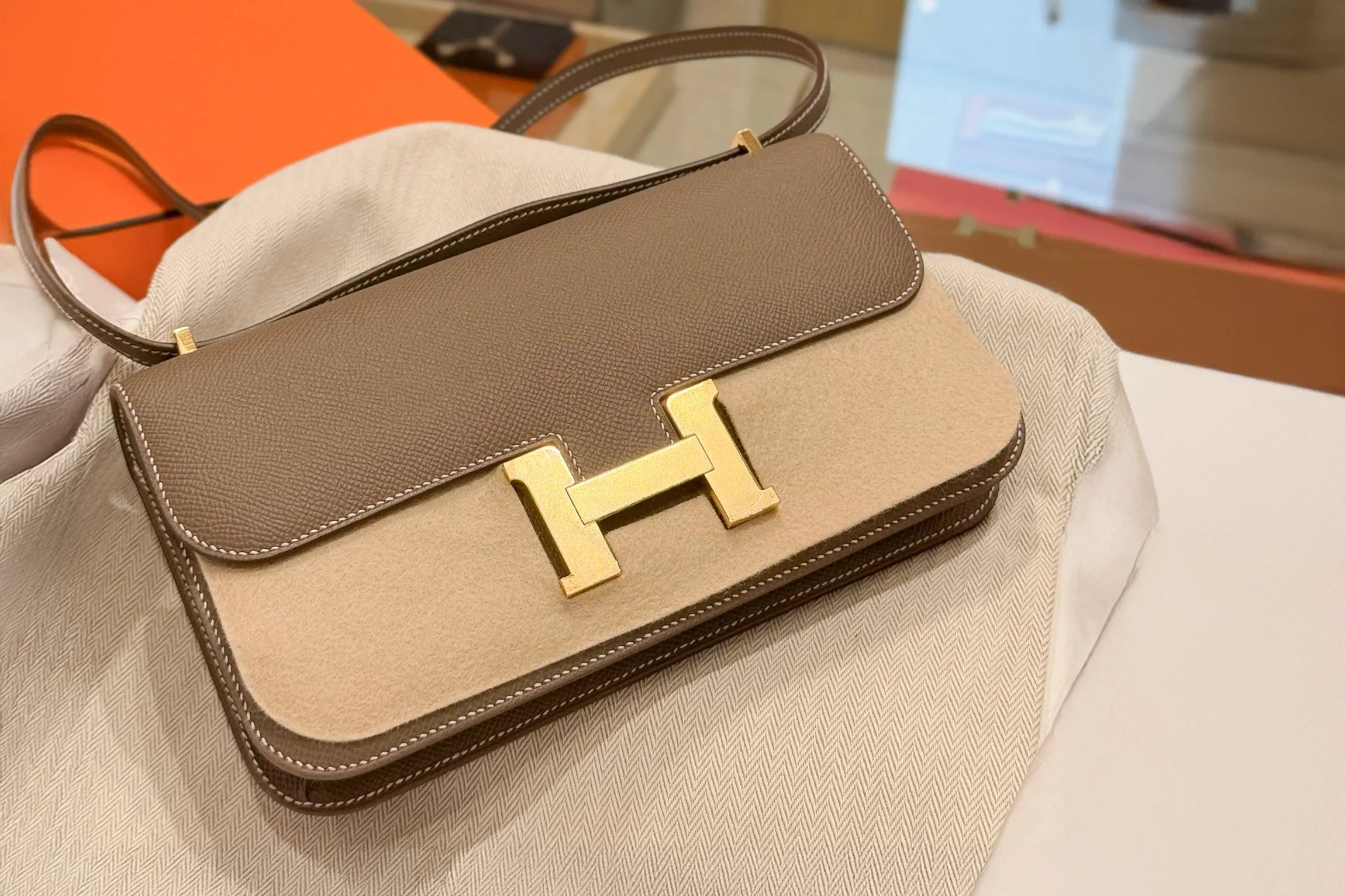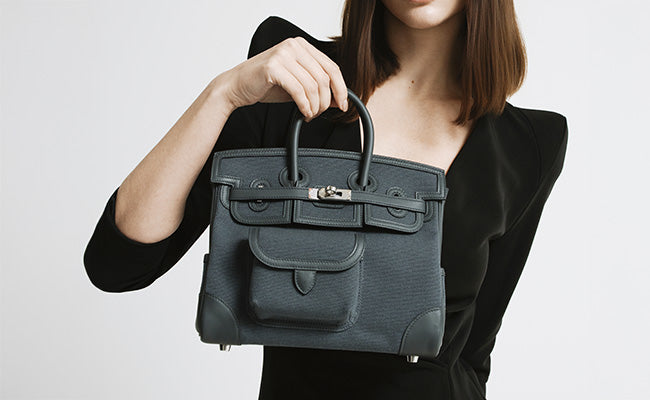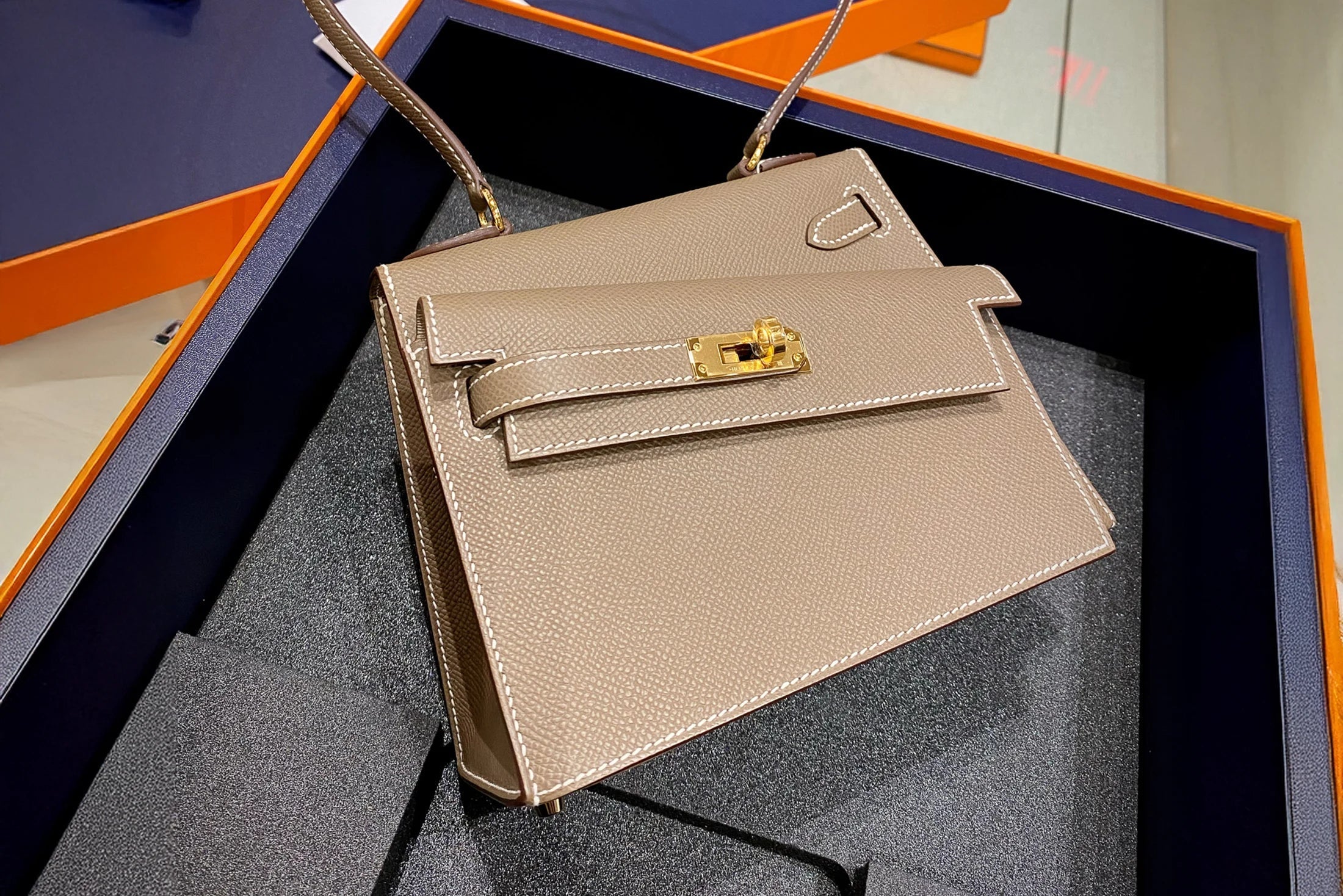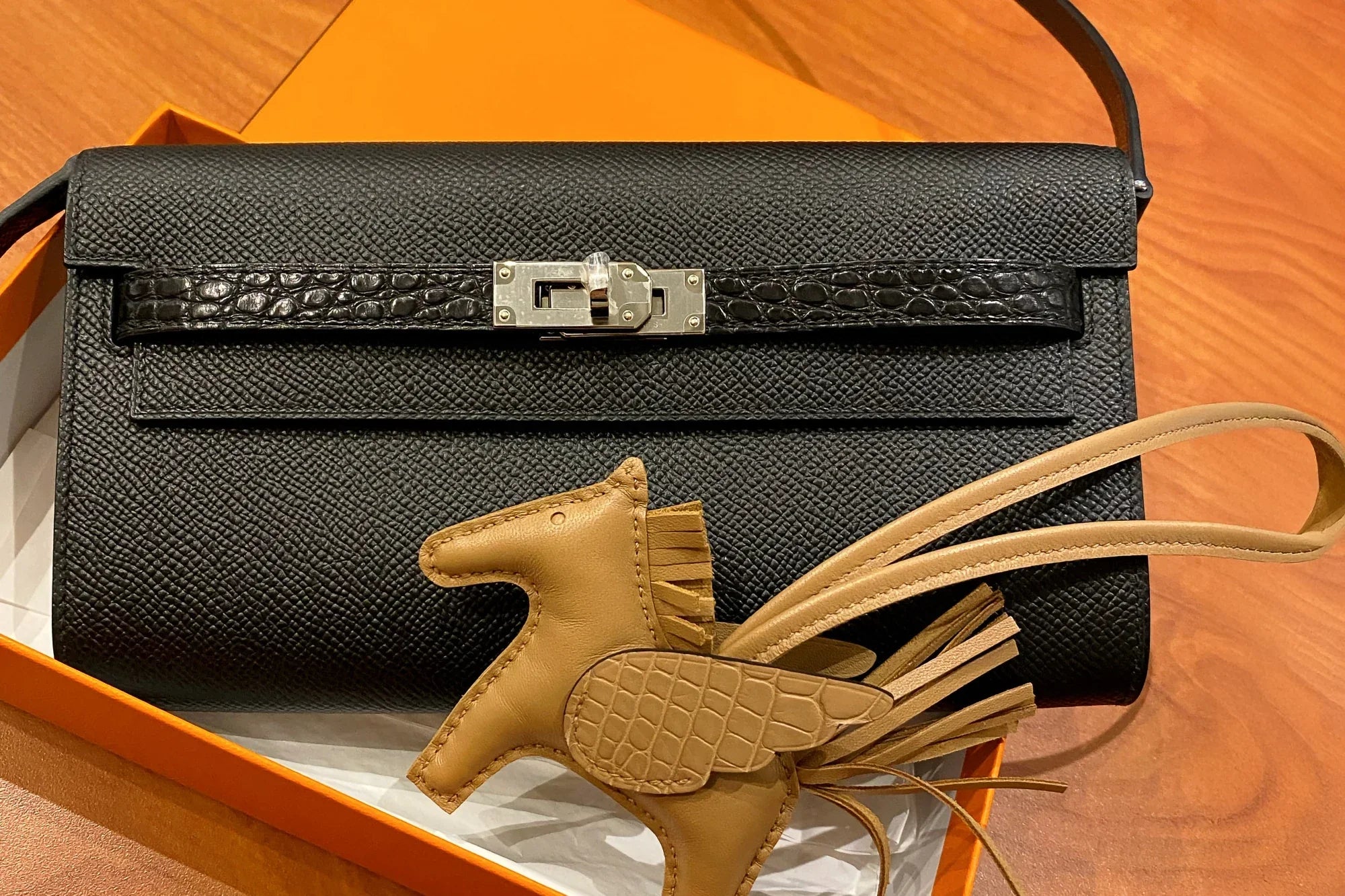
The Ultimate Leather Care Guide for Your Luxury Hermès Handbag
Check out our Hermès collection and Birkin bags!
Hermès handbags are a true symbol of craftsmanship and luxury, so it just makes sense that we’d want to keep ours looking flawless for decades. Proper leather care is the key to preserving the beauty, value, and longevity of our prized Hermès bag. We don’t need to be experts to build good care habits, but knowing what to do, and what to avoid, can make all the difference.
Whether we’re handling daily touch-ups or dealing with the occasional spill, the right care can help our bag age gracefully instead of showing avoidable damage. A few simple routines and well-chosen products will keep the leather supple and stunning.
Key Takeaways
- Daily care and safe cleaning habits are crucial for Hermès leather longevity.
- Using proper products and smart storage protects our handbag’s beauty.
- Professional care and sustainable routines help maintain lasting value.
Understanding Hermès Leather
Hermès handbags stand out for their exceptional leather varieties, each with unique charm and origins. The material and craftsmanship behind each piece shape its look, feel, and how we care for it.
Types of Hermès Leather
Hermès uses a wide range of leathers, each tailored for particular bags and customer preferences. Some of the most classic options include Togo, known for its distinct pebbled grain and scratch resistance, and Epsom, a lightweight, embossed leather with a crisp finish. Box Calf is a smooth, glossy leather favoured for formal styles, though it’s more prone to visible scratches.
We also see specialty leathers like Clemence, Swift, and Chevre, each offering unique tactile and visual qualities. Exotic choices such as alligator, crocodile, and ostrich elevate bags with their rare textures and dramatic looks. Many of us end up gravitating towards one type based on softness, structure, or appearance.
Unique Qualities and Characteristics
Hermès leathers develop unique patinas and adapt with use and care. For example, Togo and Clemence tend to be more relaxed and slouchy over time. In contrast, Epsom holds its shape longer and resists collapsing.
Some leathers, like Box Calf, are prized for developing a beautiful shine but can show scratches more easily. Exotic leathers, such as Niloticus Crocodile, have a natural sheen and require delicate handling to maintain texture and lustre. Understanding each leather’s finish, grain, and resilience helps us choose the right methods and products to keep them looking their best.
Why Luxury Leather Needs Special Care
Luxury leather is delicate because of the natural treatments and minimal coatings used at Hermès. It’s sensitive to sunlight, moisture, and even the oils from our skin. Unlike heavily coated commercial leathers, Hermès leathers can absorb stains quickly if not handled properly.
Proper storage, gentle cleaning routines, and prompt attention to spills or scratches make a real difference in longevity. When we care for Hermès leather, we’re not only preserving its appearance but also protecting our investment. It’s not about pampering, it’s about maintaining those subtle details and the luxurious feel that make Hermès so coveted.
Daily Care Habits for Longevity
To protect the beauty and structure of our Hermès handbag, daily care routines matter more than we might think. Clean hands, safe storage, and small protective habits help keep leather flawless and lasting.
Proper Handling and Safe Storage
When we handle our Hermès, clean, dry hands are a must. Even small amounts of oil or lotion can transfer onto the leather, causing premature wear or spots. We avoid grabbing it with dirty or just-moisturised fingers.
We keep the bag out of direct sunlight to prevent fading and dryness. Leather breathes best in a room that's cool and not too humid. When we’re not showing it off, the bag deserves its own spot, upright and away from crowded shelves that could bend its handles or press into its shape.
Do we hang the bag by its handles? Never. That stretches the leather and can permanently distort it. If possible, we rest it on a flat surface, maybe use a felt pad to stop scratches or dye transfer from shelves.
Avoiding Everyday Hazards
We steer clear of water, no carrying our Hermès in the rain or placing it anywhere wet. Water marks are tough to remove, and even gentle dabbing can make things worse. Fast food and coffee shops are risky zones. Grease, sauces, and drinks find their way onto beautiful leather with surprising speed.
Avoid stacking items inside that aren’t necessary. Heavy or oddly-shaped objects can warp the bag, straining seams and causing bulges in the leather.
Our bag should never be left in the car, especially in sunlight or cold. Temperature swings and direct heat from a radiator can dry out or crack the leather. We treat a Hermès like it’s more fragile than it actually looks.
Using Dust Bags and Stuffing
Every Hermès arrives with a dust bag, use it every single day the bag is not in use. Dust bags are not just a nice touch from the boutique; they protect against light, dust, and scratches.
It's essential to stuff the bag with soft, acid-free tissue or a purse pillow before storing. This keeps the shape crisp and prevents sagging. We avoid newspapers or coloured tissue, as inks might transfer.
Never overstuff. We use enough support for shape, but not so much that it stretches or stresses the seams. Cotton pillowcases work in a pinch, though the Hermès dust bag always gets first preference.
Cleaning Your Hermès Handbag
Luxury handbags like ours deserve more than just an occasional wipe. From handling everyday dust to tackling surprise stains, it’s crucial to know how to properly care for the leather so it looks stunning for years to come.
Routine Surface Cleaning Techniques
We should always start with freshly washed hands to avoid transferring oils or dirt. Using a soft, lint-free microfibre cloth, we gently wipe down the surface of our Hermès bag after each use. This keeps minor dust and fingerprints at bay without harming the leather.
A small, dedicated horsehair brush is useful for cleaning seams and hard-to-reach areas. We avoid over-wetting the leather and never use baby wipes or household cleaners, they can strip natural oils and degrade finishes.
Cleaning gently in light, circular motions helps protect the fine grain. For bags exposed to the elements, a dry brush or cloth is usually enough. If our bag picks up more than just light dust, a slightly damp cloth (with cool, distilled water) is our safest bet. We always allow our bag to air dry naturally and away from direct sunlight.
Safe Spot Cleaning for Stains
When the inevitable happens, a splash of coffee or touch of lipstick, we act as quickly as possible. Blot, don’t rub, using a clean microfibre or 100 percent cotton cloth. For liquids, gently dab to absorb as much as possible before further cleaning.
Here's a quick reference for common stains:
| Stain Type | First Step | Next Step |
|---|---|---|
| Water | Blot gently | Air dry away from heat |
| Oil/Grease | Blot with dry cloth | Sprinkle cornstarch, brush off after 1 hr |
| Dye Transfer | Blot, no scrubbing | Contact professional |
| Makeup | Blot and dab lightly | Use soft dry brush |
We avoid overworking the leather, and if gentle blotting doesn’t help, we stop and seek qualified assistance. Testing any cleaning method on an inconspicuous spot before proceeding can prevent heartbreak. For stubborn stains, we keep our hands in our pockets and let a pro handle it.
When to Use Professional Cleaning
Professional cleaning isn't just for disasters; sometimes, a yearly spa day is the best choice for our Hermès treasures. If we notice ingrained dirt, colour loss, cracking, or persistent stains, it’s time to consult someone with Hermès expertise.
Not all cleaning services are equipped to handle delicate, high-end leathers like Swift, Epsom, or exotic crocodile skins. We always confirm a cleaner’s credentials and request examples of similar restorations.
We should remember that professional cleaning can also include reconditioning, hardware polishing, and even minor repairs. For rare and vintage pieces, we sometimes opt for the Hermès “spa” service directly through the maison, which expertly restores the unique character of our beloved handbag.
Conditioning and Moisturizing Leather
Proper conditioning and moisturising prevent dryness, cracking, and premature wear in our Hermès handbags. Different types of leather, from Togo to Box Calf, require specific products and practices for the best results.
Selecting the Right Leather Conditioner
Choosing a leather conditioner for our Hermès handbag isn’t as simple as grabbing whatever is in the shoe aisle. We should look for pH-balanced conditioners that are free of silicones, waxes, and heavy oils. Many luxury leather conditioners specify that they're suitable for delicate, high-end leathers like those Hermès uses.
Togo, Clemence, Epsom, and Box Calf are all popular Hermès leathers, and each responds a bit differently. For example, Box Calf is particularly sensitive and benefits from a cream-based conditioner, while Togo and Clemence take well to slightly richer formulas. Always check the product label and, when in doubt, test on a hidden area first.
Our go-to picks include Saphir Médaille d'Or and Collonil 1909, both highly regarded by Hermès enthusiasts. We're after conditioners that enhance sheen and suppleness without clogging pores or leaving residues.
How Often to Moisturize
How frequently we should moisturise depends on how often the bag is used and the local climate. In Canada, the dry air in winter means conditioning every two to three months is ideal for regular use, whereas less frequent use may only require care twice a year.
For bags that see daily outings or travel with us through changing weather conditions, we need to check for signs of drying or dullness more often. If our Hermès is stored for months, an annual moisturising session keeps the leather in top shape.
We should avoid over-conditioning. Too much product can soften the structure or cause buildup, especially on Hermès' more delicate leathers. When in doubt, it's best to err on the side of caution and stick to a light schedule.
Application Tips for Optimal Results
Before applying any product, dust bags off gently with a soft, dry cloth. It's important to apply conditioner sparingly, using a clean lint-free cloth in small circular motions. For stubborn areas, use a barely-dampened cloth first and dry thoroughly before conditioning.
Avoid metal hardware and stitching as much as possible, since conditioner can tarnish hardware or affect thread integrity. A little goes a long way with these products – less is truly more. Always let the bag dry naturally and buff lightly with another clean cloth for a soft shine.
To make life easier, we've found it helpful to keep a small Hermès-approved care kit nearby. Moisturising shouldn’t feel like a chore; turn it into a small ritual with music and your favourite tea.
Protecting Against Weather and Elements
Weather and the environment can be less than kind to our treasured Hermès handbags. Specific steps, rather than luck, keep our leather looking luxurious season after season.
Guarding Against Rain and Snow
We all know water is the enemy of high-end leather. Hermès bags, especially in softer leathers like Togo or Swift, absorb moisture quickly and risk water spots if we get caught in a downpour or flurries.
It's essential to keep a small, soft microfibre cloth in our bag for quick blotting, not rubbing. If we expect bad weather, we use a rain cover specifically designed for our bag or a basic clear plastic cover (just not a supermarket bag, please).
Never use a hair dryer or direct heat to dry our bag. Allow it to air-dry at room temperature, stuffing tissue paper inside to help the shape hold. A quick tip: after cleaning off moisture, apply a neutral, high-quality leather conditioner once the bag is fully dry.
Quick Checklist for Wet Weather:
- Carry a dry microfibre cloth
- Use a fitted rain cover or clear umbrella
- Air-dry naturally, away from heat
- Condition the leather after moisture exposure
Preventing Sun Damage
Direct sun is a silent hazard. Prolonged exposure can pale even the richest Bordeaux or Etoupe and can dry the leather until it’s brittle. We try not to leave our bag on the dashboard or next to windows, where sunlight beams strongest.
If we’re out and about, it helps to keep our Hermès beauty in the shade or inside a dust bag when not in use. The sun can also fade hardware, so we avoid displaying our bag in direct light at home.
For additional protection, a professional-grade UV leather protectant (suitable for handbags) can be applied every few months. This helps slow down fading and drying.
Pro tips:
- Never store on windowsills or in cars
- Use dust bags even when on display
- Apply a UV protectant designed for leather
Humidity and Storage Conditions
Humidity control matters just as much as sunlight and rain. When it gets too damp, leather grows mildew; too dry, and it cracks. We steer clear of storing bags in basements or any spot that feels clammy.
Our Hermès handbags belong in their original dust bags, standing upright, and definitely not wrapped in plastic or vinyl, which just traps unwanted moisture. Silica gel packets nearby (not directly on the bag) soak up extra humidity, it’s a small step, but it makes a difference.
If the air’s bone-dry in winter, we’ll run a little humidifier in the storage room, but never right at the bag. Every so often, we rotate bags to give them a breath of fresh air and a bit of light (never direct sun, though) to keep the leather happy.
Storage Do’s and Don’ts Table:
| ✔️ Do | ❌ Don’t |
|---|---|
| Store upright in dust bag | Store in plastic |
| Add silica gel nearby | Use mothballs |
| Keep out of damp areas | Store near heaters |
Handling Hardware and Accents
Caring for a Hermès bag isn’t just about the leather. Those shiny bits, clasps, zippers, and accents, need some love, too. If we keep the hardware in good shape, the whole bag just feels better, you know?
Safely Cleaning Metal Hardware
Hermès hardware comes in palladium, gold plating, or brushed steel, so we stick to non-abrasive methods. We wipe the metal with a soft microfibre cloth, like the kind for jewelry, gets rid of fingerprints and dust without scratching.
If there’s a stubborn spot, we’ll dampen the cloth with a touch of distilled water, then dry right away. We skip chemical jewelry cleaners, bleach, or vinegar, those can mess with the finish.
Metal polishes? Nope, unless Hermès specifically says it’s okay. They can strip coatings or mess up engraved logos. Around screws and hinges, we’re extra gentle, scrubbing too hard can loosen things or dull the shine. Spotting rust or green residue? That’s a job for a Hermès pro.
Preserving Stitching and Details
Hermès’s saddle stitching and those unique accents deserve careful attention. We dust seams and threads with a soft, dry brush, even a small paintbrush does the trick. Moisture is trouble for stitching; it weakens threads and can bring on mold.
If there’s enamel or inlays, we buff with a lint-free cloth and skip the solvents. Over-handling metal plaques isn’t great either, skin oils cloud them over time.
When storing, we separate hardware and bag details with felt or silk pouches to prevent scratches. Checking for loose threads or bits every so often helps us fix small issues before they turn into real headaches.
Long-Term Storage Solutions
Keeping Hermès bags safe from humidity, sunlight, and little accidents is the secret to preserving their color, shape, and feel. A bit of prep and smart packing keeps them looking sharp year after year.
Choosing the Right Storage Environment
We look for a spot that’s clean, dry, and out of direct sunlight. Leather hates UV rays, they fade and dry it out, even the tough Hermès stuff. Best to aim for room temp, around 18-22°C, and humidity between 40 and 50 percent.
Never leave bags near radiators, heaters, or air vents. Temperature swings and dampness spell disaster. Basements and attics? Usually too unpredictable.
A shelf or cabinet lined with cotton fabric helps fend off scratches. Some folks go all out with custom glass cases and dehumidifiers, but even a simple setup works if you’re careful.
Packing Hermès Bags for the Off-Season
Before tucking bags away, we empty and clean them, no old receipts or crumbs. We use acid-free tissue paper or bubble wrap to help keep their shape, but don’t overstuff. Newsprint or colored tissue is a no-go; it can transfer dye.
We stick to the original Hermès dust bag or a 100% cotton stand-in. Zippers and straps stay loose, and we never fold the bag. Bags go upright, not stacked, so they don’t get squished.
A quick checklist:
- Clean the bag
- Stuff with acid-free paper
- Dust bag on
- Store upright, side by side
- Never stack
If humidity’s a worry, a small silica gel pack inside (not touching the leather) helps. Every few months, we open and air out the bags to keep them fresh.
Professional Services and Authentication
Even with careful home care, sometimes Hermès bags need expert hands. It’s good to know when to call in the pros, and how to protect your investment’s authenticity.
When to Seek Handbag Spa Treatments
Luxury leather ages, sometimes it needs more than a gentle wipe-down. If our Hermès bag gets stubborn stains, scratches, color fading, or starts to sag, a professional spa can bring it back to life.
When does a “bag spa” make sense?
- Water damage or ink stains we can’t tackle
- Hardware tarnish or big scratches
- Shape loss or sagging
- Deep conditioning for vintage or exotic leathers
We always pick a spa that knows Hermès and uses gentle methods. Overzealous cleaning can shorten even a Birkin or Kelly’s life.
Tip: Ask for a checklist of what’ll be done, and don’t be shy about requesting before-and-after photos.
Ensuring Authentic Hermès Repairs
Authenticity’s everything with Hermès, including repairs. The safest bet is official Hermès repair services.
What to keep in mind:
- Hermès only works on bags with clear provenance. If it’s second-hand, paperwork helps.
- Authorized repairs come with documentation and use only Hermès materials and hardware.
- Third-party repairs might void guarantees and risk non-authentic parts.
How to get a bag repaired by Hermès:
- Bring it (and paperwork) to a Hermès boutique.
- Fill out the repair request and review the plan.
- Get an estimate and timeline.
Official repairs keep our investment safe and guarantee authenticity, definitely not something to risk.
Restoring Vintage Hermès Handbags
Vintage Hermès bags have their own story, but years of use show. Knowing what to look for and handling older bags with care is key for restoration.
Evaluating Vintage Leather Condition
We check for typical vintage signs: dryness, cracks, fading, and color transfer. Each leather, Veau Box, Togo, Epsom, ages differently. Running a hand over the surface shows rough patches, and seams or hardware reveal any structural issues.
A simple table helps:
| Issue | What to Look For | Quick Assessment Tip |
|---|---|---|
| Dryness | Dull, stiff, flaky | Listen for creaks when flexing |
| Cracks | Fine or deep lines | Visible with direct light |
| Hardware wear | Tarnish, looseness | Gently twist, check for give |
| Colour fade | Mottled, uneven tone | Compare with inner flap |
We skip harsh products. Instead, we use gentle, pH-balanced cleaners and premium conditioners made for luxury leathers. If we spot serious issues, flaking, deep cracks, stubborn stains, it’s usually best to call in a Hermès specialist.
Special Care for Older Styles
Some vintage Hermès bags use discontinued leathers or rare finishes, so their care gets trickier. We always research the material, Porosus Crocodile isn’t Barenia Calfskin, after all. Every leather needs its own approach to avoid permanent harm.
Older styles might have hand-painted edges or fragile stitching that frays easily. We use a soft-bristled brush to gently lift debris from seams, never picking or scrubbing. Microfibre cloths help with cleaning, but we keep them just barely damp.
For protection, vintage bags stay out of sunlight in breathable dust bags. A small, unscented silica packet inside controls humidity. When unsure, we reach out to an Hermès-trained artisan, those folks know how to keep a vintage bag’s soul intact.
Sustainable Leather Care Practices
We want our Hermès bags to last, but it feels good to care for them in a way that’s better for the planet, too. The right products and habits keep bags in top shape and support a more mindful kind of luxury.
Eco-Friendly Products and Methods
Choosing sustainable care products is a simple way to cut our environmental impact. We look for leather cleaners and creams that are plant-based, biodegradable, and free from harsh stuff. Natural beeswax, olive oil, and shea butter are gentle on both leather and the earth.
Soft, reusable microfibre cloths beat single-use wipes every time. They’re washable, last ages, and save waste. We use cold water and just enough product to get the job done, no need to go overboard.
A quick sustainable care checklist:
- Use less: A little product goes a long way.
- Recycle or reuse containers.
- Skip aerosols and strong solvents.
Breathable cotton dust bags protect handbags without plastic. Fixing small scuffs instead of replacing things also helps.
Maintaining Value for Resale
A well-cared-for Hermès bag holds its value, and can fetch more on resale, when we show we’ve looked after it responsibly. Keeping notes on cleaning, products, and any pro service shows we’ve been good stewards.
Don’t over-condition; it can make leather too soft and lose shape. Gentle cleaning, airing bags after use, and storing with shape-keepers all help. If repairs are needed, certified Hermès service is a must.
Good maintenance protects our investment and gives us peace of mind when it’s time to let a beloved piece go. For today’s buyers, a documented eco-friendly routine is a real selling point.
Frequently Asked Questions
We all want our Hermès bags to look flawless, keep their value, and survive the occasional mishap. Here’s what we’ve figured out about care, cleaning, and which leathers really go the distance.
How can we ensure our Hermès handbag retains its value over time?
Keep your bag out of direct sun, away from moisture, and always store it in its original dust bag. Gentle, regular cleaning and avoiding overstuffing or rough use will help keep its structure and rarity intact.
Professional maintenance every few years is worth it. Hang onto receipts, authentication cards, and packaging, too.
What's the secret to effectively cleaning a Hermès leather bag without causing damage?
Use a clean, soft lint-free cloth for dusting and a tiny bit of distilled water for light marks, never harsh chemicals or household cleaners. A leather conditioner made for luxury bags, used sparingly, keeps the surface soft and resilient.
Always spot test new products on an inconspicuous area first.
Which Hermès leather types are known for their exceptional durability?
Togo and Clemence leathers are our top picks for durability. Both have a pebbled texture that hides scratches and ages nicely. Epsom leather is also a favorite among collectors for its structured feel and water-resistant qualities.
Looking for a laugh? What's the deal with Hermès bags and their ability to withstand a splash or two?
Honestly, no bag’s invincible. Even the fanciest Hermès can’t dodge a stray raindrop. Epsom’s a bit more water-friendly, but don’t treat your Birkin like it’s a raincoat.
A quick pat dry and a sigh of relief, that’s about the best defense.
Can we recommend a leather care kit that's a perfect match for our Hermès bag?
For Hermès, we go with kits that are pH balanced and made just for luxury leathers. Cadillac and Saphir offer gentle cleaners and conditioners. Avoid kits with waxes or dyes, they can mess with color and texture.
A soft-bristled brush is great for cleaning seams and hard-to-reach spots.
Is professional cleaning necessary for our Hermès canvas bag, or can we keep it pristine at home?
You can usually keep a canvas Hermès bag looking good with some regular care at home. Grab a soft brush or cloth, add a little mild soapy water, and gently wipe away dirt, nothing too fancy.
But if you run into stubborn stains or the bag gets really grimy, it might be time to call in a pro who knows Hermès bags inside and out.




